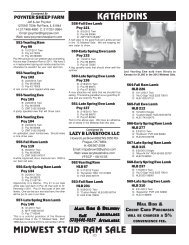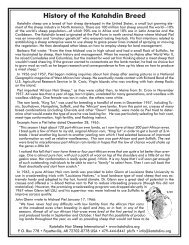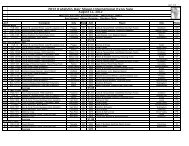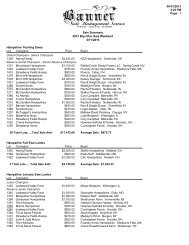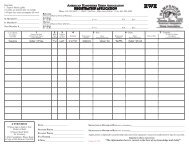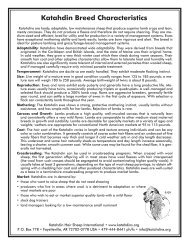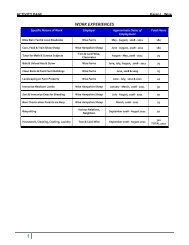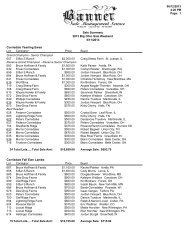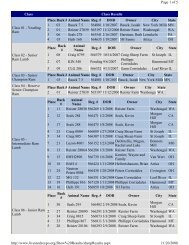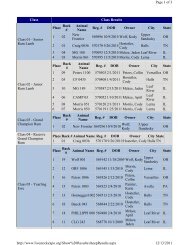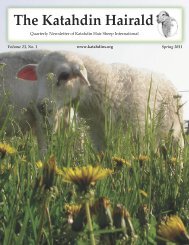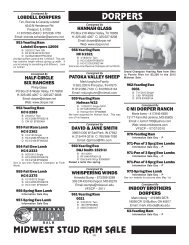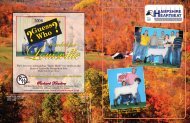KHSI Hairald Summer 2007
KHSI Hairald Summer 2007
KHSI Hairald Summer 2007
You also want an ePaper? Increase the reach of your titles
YUMPU automatically turns print PDFs into web optimized ePapers that Google loves.
Seven Year Export Status Available for the<br />
Scrapie Flock Certification Program (SFCP)<br />
Jim Morgan, <strong>KHSI</strong> Operations Office<br />
Dr John Bare, a USDA-APHIS veterinarian<br />
and Katahdin producer works<br />
with scrapie and other Transmissible<br />
Spongiform Encephalitis (TSEs). He has<br />
promised to write a more in depth article<br />
for the Fall <strong>2007</strong> Katahdin <strong>Hairald</strong> on<br />
the new program. States are just starting<br />
to implement these programs and<br />
Dr Bare will be able to more accurately<br />
report on the implementation.<br />
USDA-APHIS (US Dept of Agriculture<br />
– Animal & Plant Health<br />
Inspection Service) has recently<br />
implemented changes in SFCP.<br />
They have added an export monitored<br />
category. Those with current<br />
SFCP enrollment will see no changes<br />
unless they change to the export<br />
monitored class.<br />
Briefly, flocks in the SFCP that are<br />
certified for export will<br />
a) have a minimum of 7 years<br />
of status,<br />
b) agree to have all animals that<br />
are over 14 months of age that<br />
die on the farm necropsied for<br />
scrapie,<br />
c) The requirements are more<br />
extensive but they include the<br />
following: all cull animals over<br />
14 months of age be slaughtered<br />
at a Federal or State-inspected facility<br />
and inspected for scrapie.<br />
A minimum number of animals<br />
over 14 months of age must be<br />
necropsied for scrapie during<br />
each year (or 2 year period if no<br />
animals are culled in one year).<br />
Live animal tests for scrapie may<br />
be substituted, if no animals are<br />
culled. Producers can not substi-<br />
WHICH SCRAPIE PROGRAM, CONTINUED FROM PAGE 5<br />
tute a QR or RR animal for testing<br />
if a QQ animal is missed.<br />
There are considerable expenses<br />
to this program. Producers are not<br />
reimbursed for paying an accredited<br />
veterinarian to remove the parts of<br />
the brain and lymph node necessary<br />
to test for scrapie (charges typically<br />
range from $25 to $100). Depending<br />
on the local market for culled<br />
animals, a participant in the Export<br />
Monitored SFCP would also lose<br />
the market price for these culled<br />
animals.<br />
Most countries in the world have<br />
import requirements for sheep that<br />
mirror the requirements of this new<br />
SFCP export status. There are countries<br />
that do not allow import of live<br />
animals from Katahdin flocks (other<br />
breeds as well) in the USA, Canada<br />
and Mexico because of the lack of a<br />
7 year Scrapie program for export.<br />
This year, <strong>KHSI</strong> received a request<br />
from Costa Rica for Katahdins. The<br />
requirement was that the animals be<br />
from a 7 year scrapie program. Our<br />
office was unable to direct the buyer<br />
to a flock and Katahdin members<br />
lost potential sales.<br />
To receive a copy of the new<br />
regulations for the export category<br />
of SFCP, contact your state USDA-<br />
APHIS Office.<br />
Phone numbers for your state’s<br />
USDA-APHIS office can be obtained<br />
by asking your veterinarian or county<br />
extension agent. You can also find<br />
the phone number at the following<br />
website http://www.aphis.usda.gov<br />
/vs/nvap/vsoffice.html<br />
Katahdin Breed<br />
Reaches New Milestone<br />
By James Morgan, NSIP Katahdin<br />
Data Coordinator<br />
The Katahdin breed reached a<br />
new milestone in <strong>2007</strong>. Forty-five<br />
flocks submitted data to the National<br />
Sheep Improvement Program<br />
(NSIP). This is more than double<br />
the number of flocks submitting<br />
data than from any other breed in<br />
the USA. In fact, at least 1/3 of the<br />
total flocks submitting data to NSIP<br />
in <strong>2007</strong> will be Katahdin flocks. The<br />
Targhee range flocks are much larger<br />
and submit a similar number of<br />
lambing ewes as the Katahdin breeders.<br />
The Targhees have fewer total<br />
number of lambs since their ewes<br />
average closer to 1.6 lambs/ewe<br />
while Katahdins average twins.<br />
The new <strong>2007</strong> EPD (expected<br />
progeny difference) Sire Summary<br />
will be available on September 1 st .<br />
Sires are ranked for<br />
a) 60 day weaning wt,<br />
b) 120 day post weaning gain,<br />
c) 60 day maternal milk,<br />
d) 60 day milk + growth,<br />
e) % lamb crop,<br />
f) % weaned and<br />
g) lbs lamb weaned/ewe lambing.<br />
A subset of sires will be ranked<br />
for parasite resistance FEC-EPD (fecal<br />
egg count EPD). EPDs are the<br />
standard by which sires are ranked<br />
in the beef cattle, dairy cattle, swine<br />
and sheep industries.<br />
Contact James Morgan at 479-444-<br />
6075 or jlmm@earthlink.net for<br />
the <strong>2007</strong> Trait Leading Katahdin<br />
Sire Summary. Contact Jim if you<br />
are interesting in participating in<br />
2008.<br />
revert to the SFCP status of the new<br />
animal.<br />
The <strong>KHSI</strong> Operations Office encourages<br />
our members to educate<br />
themselves, their buyers and other<br />
<strong>KHSI</strong> members about the differences<br />
in the scrapie programs. If interested<br />
in enrolling in SFCP, shepherds<br />
should contact their state’s USDA-<br />
APHIS office.<br />
Phone numbers for your<br />
state’s USDA-APHIS office can<br />
be obtained by asking your veterinarian<br />
or county extension<br />
agent OR at the following website:<br />
http://www.aphis.usda.gov<br />
/vs/nvap/vsoffice.html<br />
SUMMER <strong>2007</strong><br />
The Katahdin <strong>Hairald</strong> • www.<strong>KHSI</strong>.org Page 5



